Years ago, I was thrilled when I came across a map online showing a fun weekend excursion: a long motorcycle ride into the mountains of Pingtung County (屏東) going almost up to the border with Taitung County (台東), followed by a short hike up to a mountain lake with the mysterious name of “Small Ghost Lake” (小鬼湖). I shared it with a more experienced hiking friend who then proceeded to laugh.
Apparently, this road had been taken out by landslides long before and was never going to be fixed. Reaching the lake this way — or any way that would constitute an easy weekend trip — was now impossible. In the years after this, I kept my ears open for stories of hikers reaching this lake. I mostly heard tales of mud, leeches, bushwhacking, getting lost and multiple days of general suffering to reach the lake in a very roundabout way. Eventually, I found the courage, or lost enough good sense, to commit to a Twin Ghost Lakes trip, visiting first Big Ghost Lake (大鬼湖) to the north and then Small Ghost Lake.
REVERED BY THE RUKAI
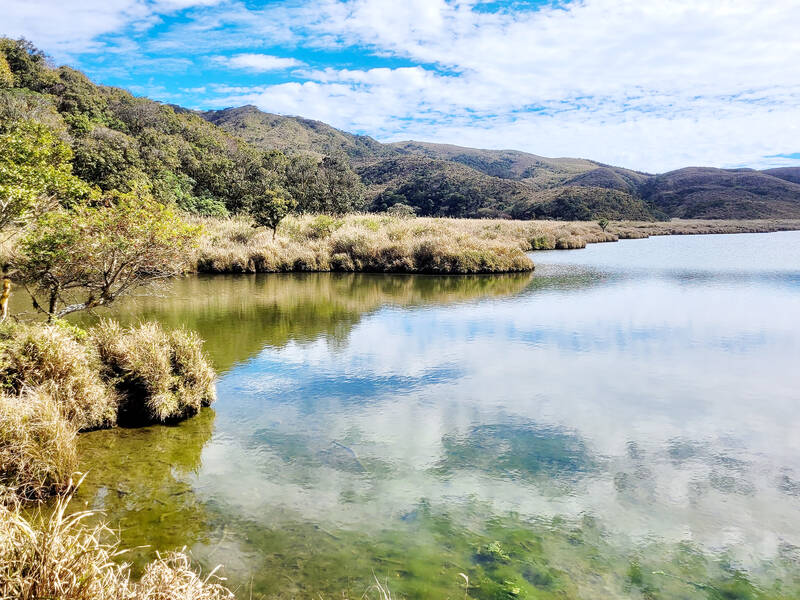
Photo by Tyler Cottenie
Follow the rivers up from nearly any Rukai settlement and you will eventually reach Big Ghost Lake or Small Ghost Lake at the top of the watershed. When the Rukai migrated from eastern Taiwan to western Taiwan, their route also took them past Small Ghost Lake. It’s therefore hardly surprising that these lakes have long played an important role in Rukai tradition.
According to legend, the daughter of a chief once fell in love with a handsome young man from outside their village, and they soon decided to marry. Before the marriage could take place, however, it was discovered that the man was actually an incarnation of the Snake King — the hundred-pacer viper spirit who guarded Taidrengere, as Small Ghost Lake is known in Rukai. The tribe opposed the marriage, and the chief gave the prospective groom a seemingly impossible task to complete to earn his daughter’s hand: retrieve a seven-colored glazed bead from the ocean.
After three years, the Snake King finally returned with the bead and was married to Princess Balenge. The newlyweds proceeded to Taidrengere, where they continue to watch over the Rukai people today. Though the lake is within the Rukai’s traditional territory, they still do not hunt in the area, out of respect for the Snake King and the princess. Another taboo prohibits making excessive noise near the lake.
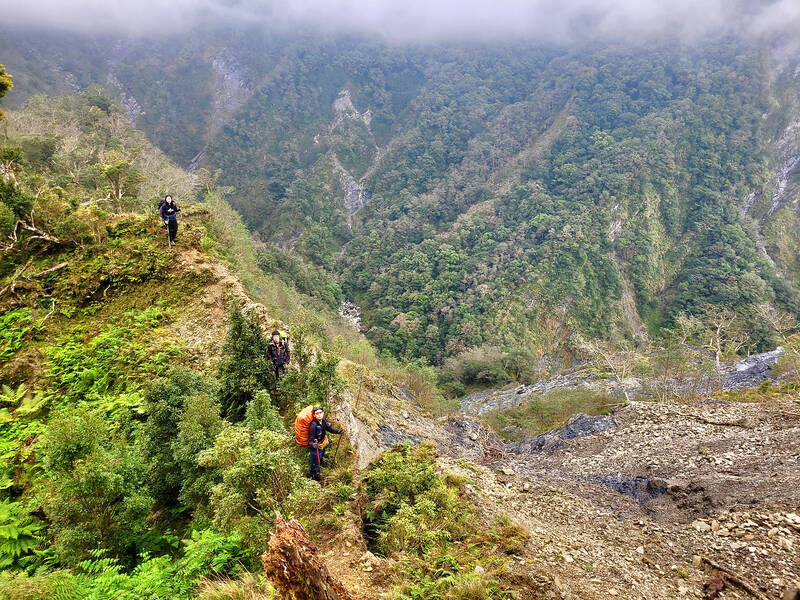
Photo by Tyler Cottenie
REVERED BY HIKERS
For decades, this second taboo was frequently broken by outsiders, as the lake was a very popular and easily accessible camping and hiking destination. Not only that, but there was marble mining activity in the area until 1988. After driving to the end of Provincial Highway 24 in Wutai Township (霧台鄉), one could continue on the mining road for another 37km to a mining camp. From here, it was just a two-hour walk to the lake, with several peaks accessible nearby. The lake was a busy place and anything but quiet on the weekends.
However, the road was continually being wiped out by landslides, which eventually made it too hard for the mining operations to turn a profit. Mining stopped, and with no regular maintenance, the road soon became impassable to cars, then to motorcycles and eventually even to foot traffic. This has not discouraged hikers from visiting Small Ghost Lake entirely, however. In fact, the isolation has even added to the appeal for many.
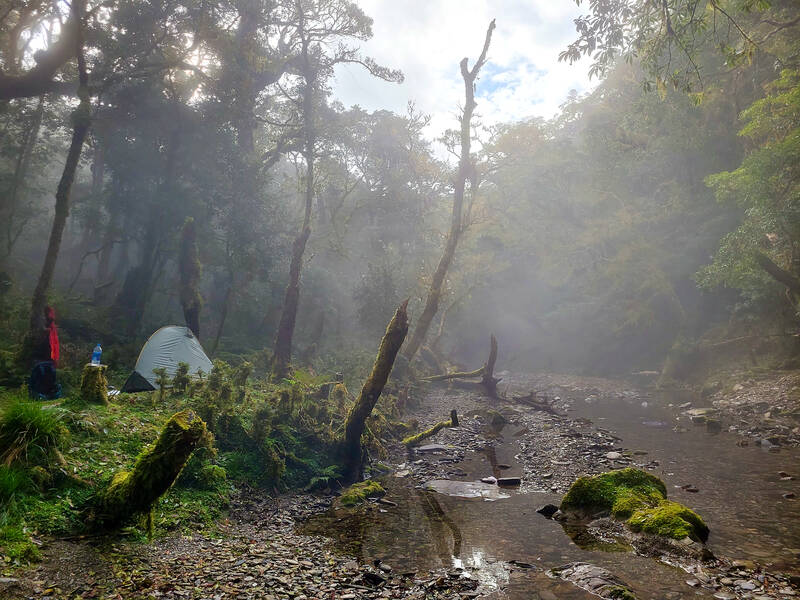
Photo by Tyler Cottenie
At 2,000 meters of elevation, the forest is frequently shrouded in cloud. This cloud condenses in the tree canopy and the resulting fog drip keeps the forest saturated, even without rain. This can make hiking less comfortable, but the moisture keeps the forest lush, with an abundance of ferns on the ground, and mosses and lichens hanging from the trees. For many, these rich greens are part of the appeal of mid-elevation hiking. With two beautiful lakes steeped in legend added to the mix, and the prospect of getting away from civilization for a week, the Twin Ghost Lakes route holds an irresistible draw for many hikers. What’s more, these lakes are the two largest in Taiwan above 2000 meters.
GETTING THERE TODAY
With the mining road wiped out, the way in to Small Ghost Lake has become a lot more difficult. Since it now takes four or five days to visit either Big or Small Ghost Lake on their own but only a week to visit both, most hikers now opt to see both at once. After leaving Big Ghost Lake, the route south to Small Ghost Lake passes the thrilling Yaobai Mountain (遙拜山), whose peak is reached by scaling a vertical rock wall using ropes and tree trunks and is only wide enough for about four people to stand on at once. The next major peak, Baican Mountain (拜燦山), does not get the adrenaline pumping as much, but does feature a cave nearby with golden lichen growing under impossibly dark conditions.
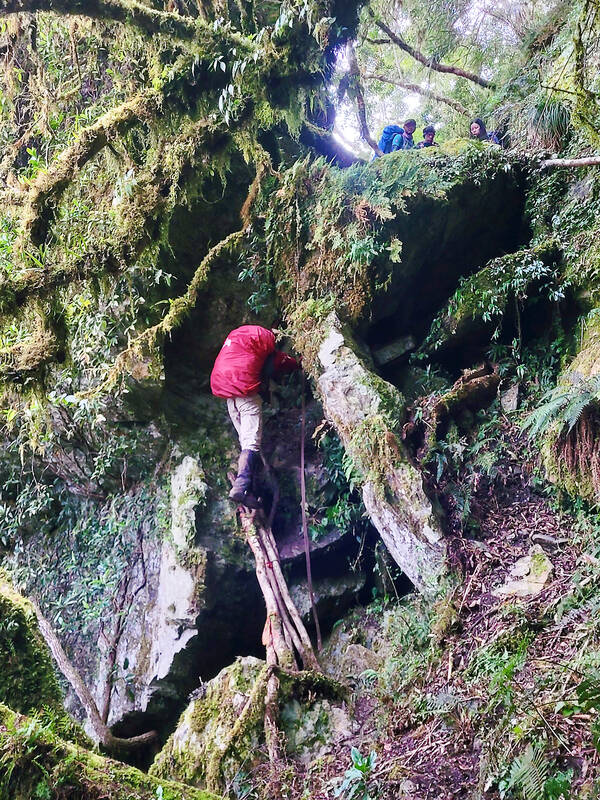
Photo by Tyler Cottenie
Later, the route makes use of the abandoned Jhihben Forest Road (知本林道), whose wide, flat surface makes for some of the easiest walking on the entire trip. Just before reaching Small Ghost Lake, the route passes through a gorgeous meadow with unobstructed views of the entire trek to the north and south, and populated Taiwan to the east and west. It was here — and only here — that our group found phone service while walking the Ghost Lakes.
An overnight stay at Small Ghost Lake is a must. There are plenty of sunny and shady spots in which to relax nearby, as you watch the sky’s colors reflected on the lake’s surface changing from midday blues to crepuscular oranges and pinks. There are fish in the lake, intentionally stocked for research purposes a few decades ago. However, in addition to the Rukai hunting taboo, keep in mind that the area is also part of a protected nature reserve.
GETTING OUT
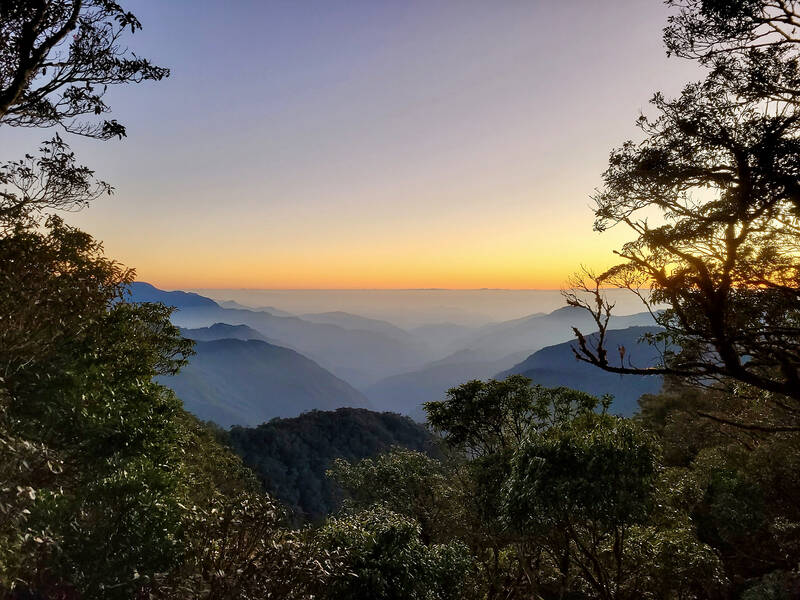
Photo by Tyler Cottenie
After visiting Small Ghost Lake, some people exit to the west, briefly following the old trail toward the mining camp but then continuing along the ridge over Pingbaoyan Mountain (屏保岩山) and down to the riverbed where the Hayousi Hot Springs (哈尤溪溫泉) are found. This route is also the quickest way to do a round trip in and out of Small Ghost Lake without visiting Big Ghost Lake or crossing over to Taitung.
We exited by heading south, crossing the Katebola River (喀特博拉溪) and then heading down past Jiadanai Mountain (加大奈山) to the Jhihben Forest Road. Along the way, we crossed something that looked like an ordinary logging road, but was actually the old Jhihben Cross-Island Road, built by the Japanese. This road was opened to cross-island car traffic in 1945 but with the end of the war came the end of maintenance and the road was immediately abandoned. The western section of this road did get a second life: as the mining road that used to provide such easy access to Small Ghost Lake. I had finally set foot on the road that first brought Small Ghost Lake to my attention; ironically it was on the other side of Taiwan.
Whichever route you choose to access Small Ghost Lake, careful research must be done ahead of time. During the hike, good map-reading skills and GPS tracking are essential, as much of the route has no visible trail to speak of. The route is also best attempted in winter, when temperatures are more comfortable, thunderstorms are rare and leeches are few.
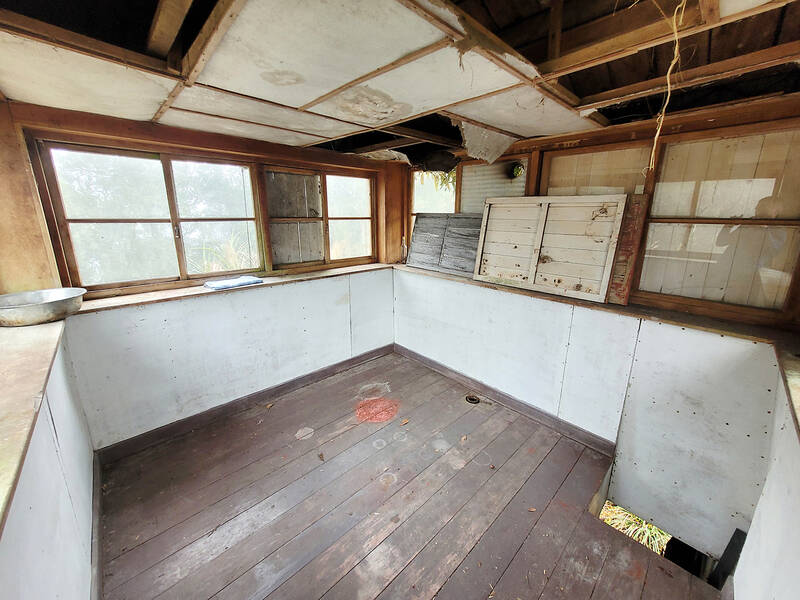
Photo by Tyler Cottenie

Taiwan doesn’t have a lot of railways, but its network has plenty of history. The government-owned entity that last year became the Taiwan Railway Corp (TRC) has been operating trains since 1891. During the 1895-1945 period of Japanese rule, the colonial government made huge investments in rail infrastructure. The northern port city of Keelung was connected to Kaohsiung in the south. New lines appeared in Pingtung, Yilan and the Hualien-Taitung region. Railway enthusiasts exploring Taiwan will find plenty to amuse themselves. Taipei will soon gain its second rail-themed museum. Elsewhere there’s a number of endearing branch lines and rolling-stock collections, some

The Democratic Progressive Party (DPP), Chinese Nationalist Party (KMT), and the country’s other political groups dare not offend religious groups, says Chen Lih-ming (陳立民), founder of the Taiwan Anti-Religion Alliance (台灣反宗教者聯盟). “It’s the same in other democracies, of course, but because political struggles in Taiwan are extraordinarily fierce, you’ll see candidates visiting several temples each day ahead of elections. That adds impetus to religion here,” says the retired college lecturer. In Japan’s most recent election, the Liberal Democratic Party lost many votes because of its ties to the Unification Church (“the Moonies”). Chen contrasts the progress made by anti-religion movements in

Could Taiwan’s democracy be at risk? There is a lot of apocalyptic commentary right now suggesting that this is the case, but it is always a conspiracy by the other guys — our side is firmly on the side of protecting democracy and always has been, unlike them! The situation is nowhere near that bleak — yet. The concern is that the power struggle between the opposition Chinese Nationalist Party (KMT) and their now effectively pan-blue allies the Taiwan People’s Party (TPP) and the ruling Democratic Progressive Party (DPP) intensifies to the point where democratic functions start to break down. Both

This was not supposed to be an election year. The local media is billing it as the “2025 great recall era” (2025大罷免時代) or the “2025 great recall wave” (2025大罷免潮), with many now just shortening it to “great recall.” As of this writing the number of campaigns that have submitted the requisite one percent of eligible voters signatures in legislative districts is 51 — 35 targeting Chinese Nationalist Party (KMT) caucus lawmakers and 16 targeting Democratic Progressive Party (DPP) lawmakers. The pan-green side has more as they started earlier. Many recall campaigns are billing themselves as “Winter Bluebirds” after the “Bluebird Action”